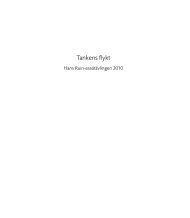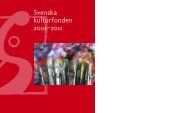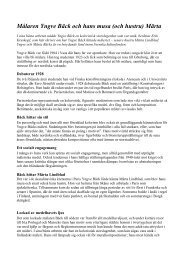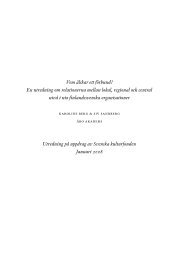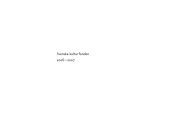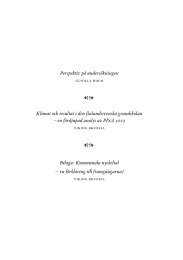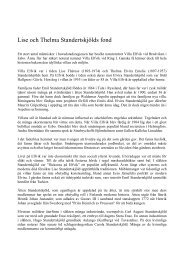Sesam - Svenska kulturfonden
Sesam - Svenska kulturfonden
Sesam - Svenska kulturfonden
You also want an ePaper? Increase the reach of your titles
YUMPU automatically turns print PDFs into web optimized ePapers that Google loves.
markus Kåhre’s work of art rewards<br />
the one who passes through<br />
Timo Valjakka<br />
I seize the door handle and get startled. Turning<br />
the handle set a rubber ball off, which, after<br />
first having hit the arched upper edge of the<br />
window in the door and having for a few seconds<br />
bounced in front of me, finally disappeared in<br />
one of the holes at the base of the window to<br />
await the next person to pass through the door.<br />
Had the ball hit another hole, then the ball<br />
would have triggered a carousel mechanism, the<br />
movement of which would have rewarded me<br />
with a chocolate sweet wrapped in blue paper.<br />
Markus Kåhre says that art should change<br />
something in a person. He notes that were he<br />
to accomplish even one smile in the middle<br />
of the working day, then he has accomplished<br />
something.<br />
The door to the meeting room at the Swedish<br />
Cultural Foundation in Finland is, in addition<br />
to being quite a regular door, also a mechanic<br />
and interactive work of art fashioned by Kåhre.<br />
Its starting point was to make the everyday act<br />
of stepping through a door into an event of<br />
meaning. Opening the door to the meeting room<br />
no longer signifies the transfer from one space<br />
into another. On the contrary, the artist surmises<br />
that each person passing through the door<br />
will stop and see if he was lucky. When Kåhre<br />
primed the trajectory of the ball in his study, he<br />
estimated that there will be a reward on average<br />
every tenth time the door is opened.<br />
When the Swedish Cultural Foundation in<br />
Finland invited Kåhre to submit a draft for a<br />
work to be placed on the door of the meeting<br />
room door, he felt suspicious about the idea, but<br />
he also felt it was a challenge. Kåhre states that a<br />
work set in a public space has to be durable, and<br />
not only physically so. He continues that it must<br />
not develop into blandness even were it to be<br />
passed by tens of times a day.<br />
It was evident from the beginning that no<br />
traditional work of art would come in question.<br />
The artist, known for his large room-sized<br />
installations and spectator-bewildering illusions,<br />
could also not resort to earlier approved solutions.<br />
The birth history of the work depicts well Kåhre’s<br />
method of working. The idea came to life in a<br />
tram cart as he was on his way to inspect the<br />
future place of his work set in a door at the<br />
premises of the Swedish Cultural Foundation<br />
in Finland at Simonkatu. Kåhre reports that he<br />
was at the Hakaniemi square when he thought<br />
of sculptor Matti Nurminen. Suddenly he<br />
remembered that Nurminen had said in quite a<br />
different context that the handle is paramount,<br />
that the handle is the starting point if one ever<br />
were to fashion a door.<br />
What if something unexpected occurred when<br />
the handle was touched, Kåhre mused. His<br />
thoughts raced rapidly and the first concepts of<br />
the work were already finished in his mind before<br />
the tram stopped in front of the Central Railway<br />
Station. Only the execution of the work remained.<br />
The draft sketch was done the same evening.<br />
The artist points out that his works are whims<br />
– something that seizes one along just enters his<br />
mind. According to researcher Leevi Haapala, the<br />
art of Kåhre processes questions arisen from such<br />
creative thinking that is inspired by idleness and<br />
curiosity.<br />
Although the execution of each work of art<br />
by Kåhre requires a lot of planning and work,<br />
one can hardly by the finished work notice the<br />
materials and technical solutions in solving all<br />
of that which is connected to executing even an<br />
impossible sounding idea. The physical is also<br />
forgotten every time when the light-colored<br />
rubber ball shoots away, even though the great<br />
16 – 17<br />
decisions of subsidies of the cultural foundation<br />
are made specifically in that meeting room.<br />
The door is one of Kåhre’s smallest works of<br />
art. Normally his works are large, constructed<br />
situations related to theater, where the spectator<br />
suddenly finds him/herself on the stage. In<br />
an untitled work (Kåhre hardly ever titles his<br />
works of art), the onlooker looks into a mirror,<br />
but cannot see his/her image. In another the<br />
onlooker steps into a dark room and sees above<br />
him/her a brightly sparkling star sky, as well as<br />
how a row of white flags are flapping in a blustery<br />
wind despite the work being indoors. The<br />
spectator finds in the installation The Banquet<br />
(2010) that he/she has stepped into a virtual<br />
restaurant where a group of wise people are<br />
discussing love. The installation is based on the<br />
writings of Plato.<br />
Kåhre executed his to date most extensive work<br />
of art together with Susanne Gottberg for the<br />
Amos Anderson Art Museum in August 2009.<br />
The work was so large that it was possible to walk<br />
within it. Its starting point was the typical yard of<br />
a Helsinki perimeter block as dusk set in, when<br />
the lights in the apartment had already been<br />
switched on.<br />
The door had a central role in this work as<br />
well. At the corner of the yard, the door – as if<br />
deliberately left open – beckoned the spectator<br />
to an adventure, away from the white-walled and<br />
brightly lit reality of the art museum.<br />
As with several works of contemporary art,<br />
Kåhre’s work has conceptually long roots<br />
reaching beyond the fine arts. The shape<br />
of the window in the wall – straight lines<br />
on the nether half and arched in the upper<br />
half – readily brings to mind the classic game<br />
called Fortuna, which was developed by Juho<br />
Jussila of Jyväskylä in the 1920:ies, and which<br />
still is in production. The trigger connected to<br />
the door handle in turn refers to the efficient<br />
American pinball machine, which in Finland<br />
was aptly called an electric Fortuna, before the<br />
English loan word “flipperi” was established as<br />
its Finnish name. Both games were developed<br />
from board game bagatelle, which was invented<br />
in 18th century England.<br />
Both in pinball and Fortuna one plays for points,<br />
not prizes. Therefore the traditional Finnish slot<br />
machine payazzo has to be included in the list of<br />
game machines. In the payazzo the coin, which<br />
is used instead of a ball, awards a merrily jingling<br />
cash prize when it hits the right gate.<br />
What about the prize that Kåhre’s work presents,<br />
the chocolate sweet wrapped in shiny paper?<br />
In the entirely white and therefore almost<br />
minimalistic severe work of art the colorful<br />
wrappers of the sweets constitute a powerful<br />
visual emphasis.<br />
Kåhre muses that the door currently hold blue<br />
sweets, but that they can be replaced. He thinks<br />
that the sweets can be mutually of the same<br />
color or of varying colors or even adapted to<br />
a Christmas theme or to the season. He does<br />
not consider the details of the prize to be an<br />
essential matter. What is essential is what the<br />
work accomplishes in the mind of the person<br />
who experiences the work, when an everyday and<br />
practically insignificant occurrence suddenly gets<br />
filled with new meanings.<br />
Kåhre states that he very much likes the idea that<br />
someone at the Swedish Cultural Foundation in<br />
Finland takes the responsibility of the sweets store<br />
on his or her shoulders and that the maintenance<br />
work of the door will become for this person a<br />
fun task and something to be proud of.




